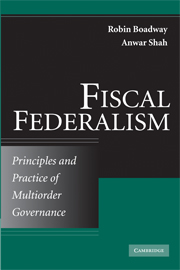Book contents
- Frontmatter
- Contents
- Preface
- PART ONE DESIGNING FISCAL CONSTITUTIONS
- 1 Introduction to Federalism and the Role of Governments in Federal Economies
- 2 The Decentralization of Government Authority
- 3 Expenditure Assignment
- 4 Revenue Assignment
- 5 Natural Resources Ownership and Management in a Federal System
- 6 Local Governance in Theory
- 7 Local Governance in Practice
- PART TWO REVENUE SHARING AND FISCAL TRANSFERS
- PART THREE FINANCE AND PROVISION OF PUBLIC SERVICES
- PART FOUR CHALLENGES AND RESPONSES
- References
- Index
5 - Natural Resources Ownership and Management in a Federal System
Published online by Cambridge University Press: 05 June 2012
- Frontmatter
- Contents
- Preface
- PART ONE DESIGNING FISCAL CONSTITUTIONS
- 1 Introduction to Federalism and the Role of Governments in Federal Economies
- 2 The Decentralization of Government Authority
- 3 Expenditure Assignment
- 4 Revenue Assignment
- 5 Natural Resources Ownership and Management in a Federal System
- 6 Local Governance in Theory
- 7 Local Governance in Practice
- PART TWO REVENUE SHARING AND FISCAL TRANSFERS
- PART THREE FINANCE AND PROVISION OF PUBLIC SERVICES
- PART FOUR CHALLENGES AND RESPONSES
- References
- Index
Summary
INTRODUCTION
Natural resource endowments in a federation are typically allocated very unevenly across the federation. To the extent that subnational jurisdictions have access to revenues generated directly or indirectly from resource exploitation, both inefficiencies and inequities can occur. In some federations, the problem is particularly pronounced because resource ownership resides with the subnational government. This decentralized ownership implies that resource revenues accrue directly to the subnational government, leading to potentially large net fiscal benefit differences. An example of this is Canada, where natural resources are owned by the provinces, although the federal government can also obtain some tax revenues through its income and sales taxes. In other cases, management is at the subnational level, although revenues are more centralized. Even in this case, uneven economic development can occur, which puts strains on the federation. Moreover, there may be tensions between subnational governments where natural resources are located and the federal government that collects the revenues if the former feel they are not getting their fair share of benefits. Of course, these tensions will be exacerbated if there is a perception that the federal government is not using the resources wisely or if there is outright corruption.
Many issues arise in federations where natural resource endowments are significant. First, there is the issue of managing the rate of exploration, extraction, and processing of the resources.
- Type
- Chapter
- Information
- Fiscal FederalismPrinciples and Practice of Multiorder Governance, pp. 207 - 241Publisher: Cambridge University PressPrint publication year: 2009



